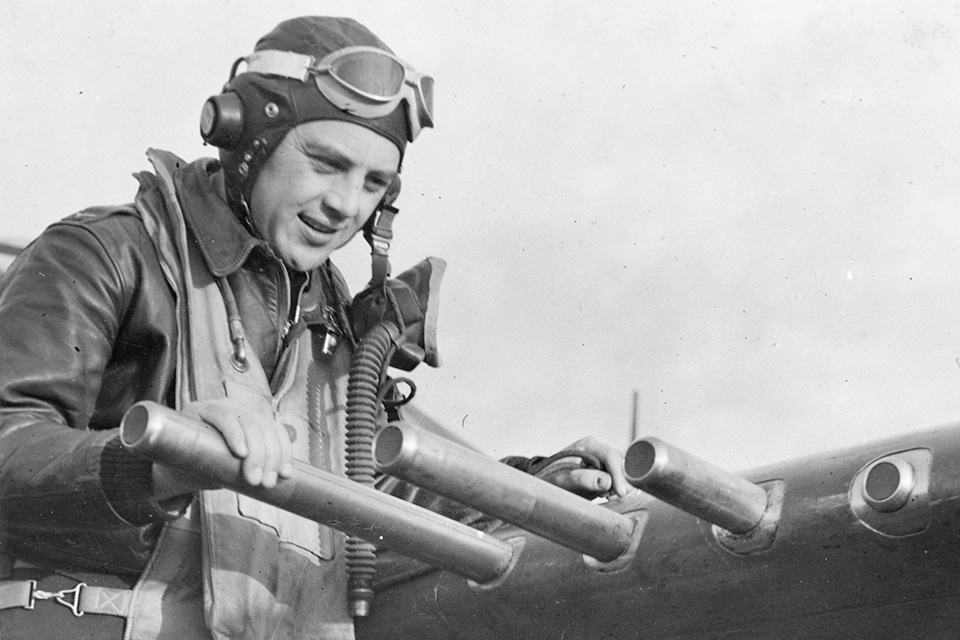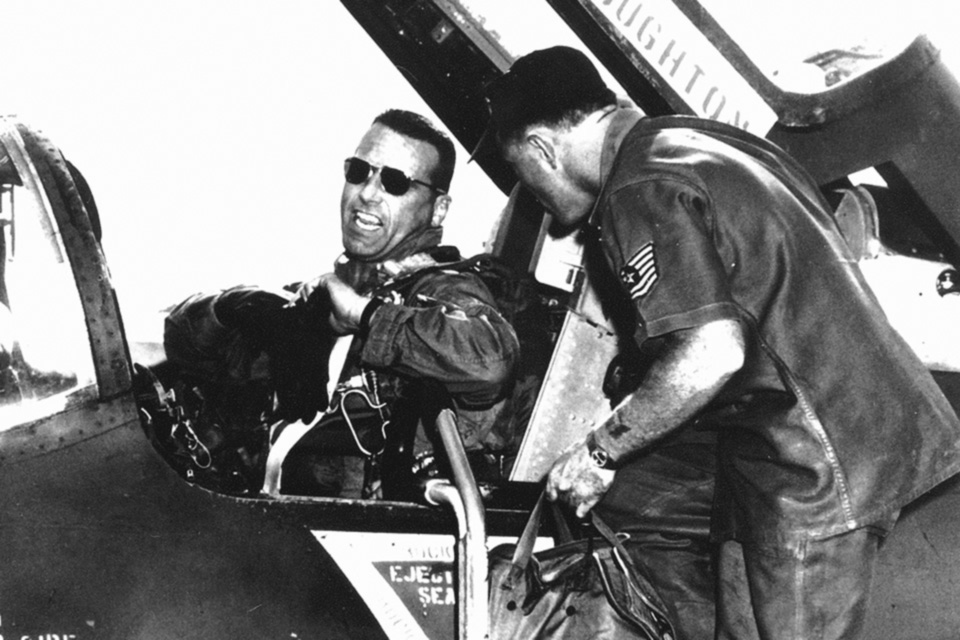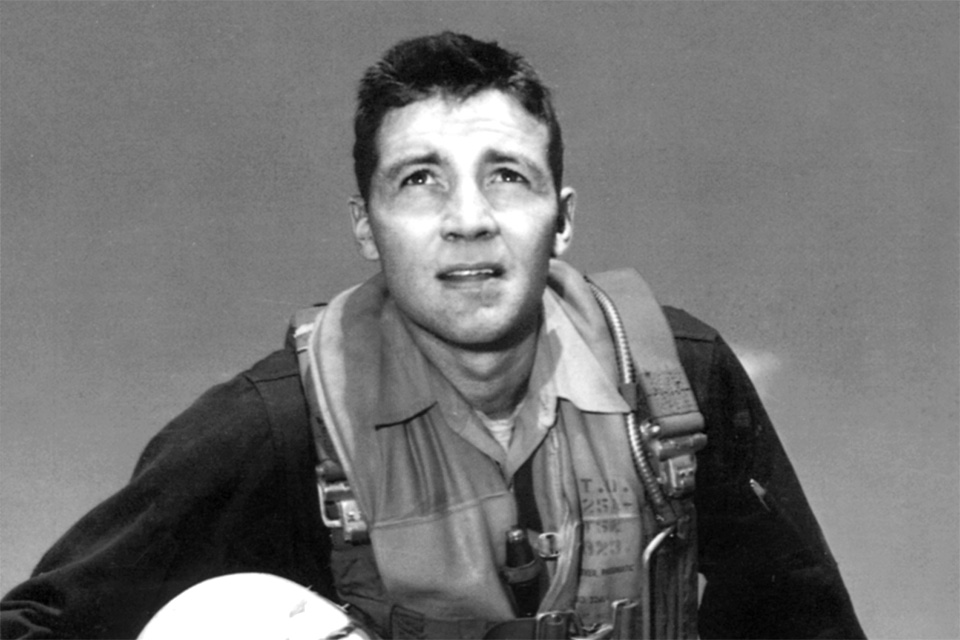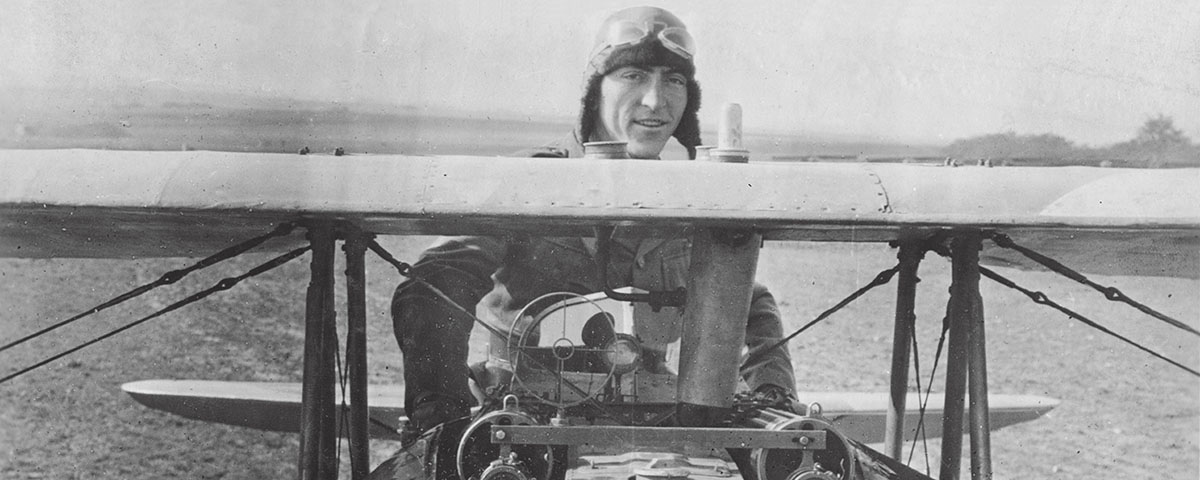In its desire for conformity, the U.S. military may be losing some of its best pilots before they ever get off the ground.
There are those who believe that a few shop-worn phrases are at the heart of many of America’s problems in the world today. These include the most powerful and sin- ister of all, “political correctness,” plus its rigorous corollaries “zero tolerance” and “one mistake and you are out.” Such catch phrases are inevitably the weapon of choice of special interest groups. Had these concepts held sway in the U.S. military years ago, all the “badass” pilots who have done so much for the country would have been cashiered well before they could demonstrate their talents. The nation would have lost the vital contributions of such aviation giants as Eddie Rickenbacker, Jimmy Doolittle, Hub Zemke, Jack Broughton, John Boyd and many others. For a wide variety of reasons, these heroes would have been dropped from the ranks early in their careers.
One has to wonder what losses the military is suffering now, when we know that any budding badass pilot will be dismissed from service at the first sign of nonconformance to the current hypercritical standards of conduct. This is absolutely not to say that genuine misconduct should be condoned and go unpunished. However, judgment and common sense should prevail. If a budding genius makes a mistake, he or she should be punished appropriately but not automatically refused promotion or eliminated from military service.
Looking back, it’s instructive to review the early careers and contributions of the above-named giants of aviation history. With hindsight it seems that many of the character traits contributing to their success would exclude them from military service in the current climate.
Edward V. Rickenbacker
Eddie Rickenbacker became America’s ace of aces in World War I despite a background that would have barred him from the enlisted ranks today. He supported his family from age 10, initially working 72 hours a week at a nickel an hour—a clean $3.60 per week. By force of his personality, courage, intelligence and talents, Rickenbacker became one of America’s top race car drivers, earning $60,000 a year (more than $1 million today) physical condition, he used his brains as much as his body by preplanning every race and drilling his pit crew until they could swiftly change tires and refuel. He drove at the edge of risk, using every trick of the trade to win.
When the U.S. entered the war, Rick volunteered to raise a squadron of fliers made up of his racing driver friends. The Army refused, saying the drivers were overage, undereducated and knew so much about engines that they might hesitate to go into combat if their motors were not running correctly.
Undeterred, Rickenbacker gave up his huge income and volunteered to drive staff cars for the Army. In France, a chance encounter with Colonel William “Billy” Mitchell (another badass pilot) allowed him to worm his way into aviation. He supervised the construction of a vast new flight-training center at Issoudun for American aviation cadets. They came by the hundreds, eager young scions of families wealthy enough to have sent them to college. Rickenbacker did a great job building Issoudun but offended many of the Ivy League trainees with his table manners, bad language and (especially) insistence that they work hard. In the interval, his zeal to serve led him to lie about his age, fake his physical and bootleg flying lessons. He eventually earned a commission and was assigned to the 94th Aero Squadron.
There Rickenbacker encountered the same societal differences. His colleagues frowned upon his lack of education, his manners and his language. Rickenbacker threw himself into his work and his flying. Perhaps most important, he knew how to get along with and inspire the mechanics of his unit. He first helped them work on the cranky 160-hp Gnome rotary engine of the Nieuport 28, and then the even less reliable 220-hp Hispano-Suiza of the Spad XIII. While most of his fellow officers looked down on his grease-stained nails, the enlisted men, upon whom the pilots’ lives depended, looked up to him. Fighting squadron animosity, the Germans and severe ear problems, Rickenbacker went on to claim 26 victories.
Under today’s rigid standards, Rickenbacker would never have been given a commission or led a squadron into combat. It’s doubtful he could have maintained a noncommissioned rank. The nation would be poorer for it, losing a prime example of a man who overcame a difficult early life to go on to a triumphant career.

James H. Doolittle
Jimmy Doolittle is best remembered for organizing and executing the famous April 18, 1942, B-25 raid on Tokyo, but that was just one aspect of his storied aviation career. An impressive physical specimen—boxer, athlete and flier—he was even more remarkable intellectually, combining brains with charm. In one demonstration of his powers, he wooed Shell Oil and the Army Air Corps into developing and stockpiling 100-octane gasoline before World War II. This extraordinarily important work was never matched by the Axis powers. He continued to fly every type of aircraft, for a while giving amazing aerial demonstrations to convince trainees that the Martin B-26 was not the “widowmaker” it was reputed to be. He was a great leader, doing excellent work commanding the Twelfth, Fifteenth and Eighth air forces. But he got there despite obstacles that would have kept him from serving today.
Commissioned in 1918, Doolittle set a dazzling pace from the start. In 1922 he flew a de Havilland DH-4 across the country with one stop in just 21 hours and 19 minutes. Next he went to Wright Field to serve as an engineer and test pilot, before earning his master’s degree in 1924 and doctorate in 1925 from the Massachusetts Institute of Technology. In 1925 he won the Schneider Trophy Race in the Curtiss R3C-2 racer now hanging in the National Air and Space Museum. There followed a seemingly endless procession of accomplishments, including performing the first outside loop and pioneering instrument flight. Despite all this there were two factors that would probably prevent his career success today.
The first of these came in 1930, when he had been a first lieutenant for 12 years and still had little prospect for promotion. His colleagues—including the young Hap Arnold, Frank Andrews, Carl Spaatz, Ira Eaker and others—were appalled when Doolittle resigned his regular commission with the intent of making a little money for his family. They held this as a black mark against him, even late in his career.
Doolittle went to work for Shell Oil, but continued as an aviation trailblazer, winning the Bendix and the Thompson trophies and setting a 296-mph speed record in the notorious Gee Bee R-1. As a member of the 1934 Baker Board, he investigated the “Air Mail Scandal” and in the process helped revitalize the Air Corps. When war clouds loomed, Doolittle returned to active duty on July 1, 1940, with the rank of major. Instead of being given a combat squadron, however, he was handed an ignominious assignment as an assistant district supervisor for procurement, working with the auto industry.
Fortunately, Doolittle’s superiors were forced to call on his talents when the Tokyo raid was being planned. It soon became obvious that he was indispensable. The successes of the raid and of his subsequent career are legendary facets of aviation history.
The second factor that would have kept Doolittle from advancement in today’s Air Force is less well known. He had a wild, un bridled side that is difficult to describe explicitly even today. Let’s just say he was not averse to taking a drink or two, or to having a flirtation or three. Further, he was famous for playing practical jokes on his air-racing colleagues that would make Charlie Sheen blush. You won’t find these officially recorded anywhere, but stories about Doolittle’s wild side were oft reported by those who knew him well, including no less august a source than Scott Crossfield. Today any hint of such behavior would result in his discharge.

Hubert A. Zemke
Like Rickenbacker, “Hub” Zemke experienced discrimination in the form of anti-German sentiment in his Missoula, Mont., hometown. This contributed to his tough, pugnacious nature, which would serve him well in the boxing ring and in aerial combat, if not in dealing with superiors.
Curiously, his interest in fisticuffs led him to box under an assumed name after he won his wings in 1937. Using a nom de guerre, Zemke competed in bouts against enlisted personnel—unheard of at the time, and darkly frowned upon when discovered.
Fortunately, like the late, great Johnny Alison, Zemke was picked for his natural flying talents to go to Britain in 1940 to study the Royal Air Force in action. The following year he traveled to the Soviet Union to instruct Russian pilots in the use of their Lend-Lease Curtiss P-40s.
Upon his return, he was given a daunting double assignment: lead the newly formed 56th Fighter Group and introduce the brand new Republic P-47 Thunderbolt to combat. Zemke’s tough discipline and devoted leadership not only shaped the group’s fantastic record, it turned the P-47 into a formidable weapon. He drove his troops with fines and threats, but most of all with steely eyes that demanded obedience. The 56th became an elite outfit, using the P-47’s impressive dive and roll rate to offset its poor climbing ability and large turning radius. Zemke was promoted to colonel in May 1943, and became an ace five months later.
Summoned to return to the U.S. by Maj. Gen. Ira Eaker, to pass on his knowledge to the still growing Army Air Forces, Zemke acceded only when promised he could return to command the 56th. Instead he was given a Stateside assignment. Furious, Zemke reacted by “deserting to combat”—he went AWOL back to Britain. There he demanded, and after much difficulty received, command of the 56th again.
He led from the front with gusto, creating the famed “Zemke Fan” that sent his Thunderbolts out in advance of the bombers, catching the Luftwaffe fighters as they were forming up. This tactical triumph was adopted across the board in Europe. Zemke next accepted command of the 479th Fighter Group, flying P-51 Mustangs. He brought his score to 17¾ aerial victories before his aircraft broke up in a storm and he became a prisoner of the Ger mans. Once again he distinguished himself, as senior Allied officer of 9,000 POWs. He represented them so well that when the Germans fled the Soviets at the end of the war, they turned over command of Stalag Luft 1 to him.
In his postwar career, Zemke held important positions including command of the 4080th Strategic Reconnaissance Wing, operating the top-secret Lockheed U-2. He retired as a colonel in 1966 after 30 years of service, bitter that despite his accomplishments, he had never been selected for flag rank.
The reason was obvious: Zemke had offended too many people, too many times. He was not regarded as general officer material. But the sad fact is that in today’s environment a person of his unyielding, nonconforming personality would likely never even be allowed to reach the position of squadron commander.

Jacksel M. Broughton
Jack Broughton lived every young fighter pilot’s dream. He was combat qualified in every Air Force fighter from the P-47 to the F-106. He led the Thunderbird demonstration team for three years, taking them from straight-wing Republic F-84s to the sweptwing F-84F to the demanding North American F-100. Broughton fought in two wars, flying 114 missions on two tours in Korea and another 104 in Vietnam. In the process he gained a chestful of decorations, including nine Air Medals, four Distinguished Flying Crosses, the Legion of Merit, two Silver Stars and the Air Force Cross.
As vice commander of the 355th Tactical Fighter Wing during the Vietnam War, Broughton made it his practice never to ask anyone to fly a mission he himself would not undertake. He also picked the toughest missions to lead into Route Pack 6, the red-hot danger zone surrounding Hanoi and Haiphong. On June 2, 1967, during one such mission, two of his majors, both veteran combat pilots, were accused of strafing a Soviet cargo ship in the harbor at Cam Pha.
Broughton was unaware of this until late in the day, when the two men briefed him that they might be accused of violating the Rules of Engagement (ROE), which forbade firing on anything that might endanger Soviet personnel, even if they were manning SAM batteries. Still stressed from his own mission, he had two choices. One was to notify headquarters and let the bureaucracy take its course, with the two majors being court-martialed. He chose instead to destroy the only hard evidence, the gun camera film from the two aircraft. He did so without a qualm, fully aware that he was now responsible for the outcome.
A nightmare of vindictive bureaucratic wrangling followed. The White House had demanded punishment for anyone who violated the ROEs. The commander in chief of Pacific Air Forces, General John “Three Finger Jack” Ryan, complied. He disregarded the finding of the Article 32 pretrial review board and pressed for a court-martial.
The Air Force could have handled the matter quietly, dismissing the incident with a summary nonjudicial judgment and a suitable reprimand. Ryan would have none of it, demanding instead a court-martial for three of the bravest, most effective combat pilots under his command. The potential penalty was dismissal from service with loss of pay and allowances, including retirement benefits, and 12 years or more in prison.
The court-martial at Clark Air Base in the Philippines was veiled in secrecy. No one wanted to serve as president of the board, a responsibility that finally devolved on then-Colonel Charles “Chuck” Yeager. He was perhaps the only officer in the theater who could execute the task without fear of either reprisal from above or resentment from below.
Broughton’s swift reaction in destroying the film meant there was no evidence against the majors, who were quickly released from the trial. He was convicted of lesser charges, fined $100 a month for six months and admonished. His chances for a future command were gone, but not his chances for vindication.
Having fought enemy fighters and dodged missiles in two wars, Broughton was not about to let a court-martial shoot him down. In 1968 his court-martial conviction was set aside, privately characterized by a member of the Air Force Board for Correction of Military Records as “the grossest miscarriage of military justice he had ever seen.” The only other officer in the history of the U.S. air forces to have a general court-martial set aside and voided was Brig. Gen. Billy Mitchell.
Broughton retired immediately thereafter, going on to write two classic books about the Vietnam War, Thud Ridge: F-105 Thunderchief Missions Over Vietnam and Going Downtown: The War Against Hanoi and Washington. Jack’s youthful service was colorful and probably would stretch approval limits in today’s climate. But it was his steadfast defense of his officers, putting his own career on the line, that is important here.

John R. Boyd
Anyone who has read Robert Coram’s superb Boyd: The Fighter Pilot Who Changed the Art of War knows that Colonel John Richard Boyd is the perfect poster boy for this article. Coram reveals how “Forty-Second Boyd” went from being known as the best fighter pilot in the world to a modern-day Sun Tzu. His reputation as a fighter pilot derived from his oft-demonstrated capability to defeat any opponent in a simulated dogfight in less than 40 seconds. His recognition as a warrior/philosopher derived from a much longer and far more important but scantily documented lifetime of study.
Unlike Giulio Douhet or Billy Mitchell, Boyd left behind no major body of work on his philosophy of air power. A gifted engineer, he possessed the unique capacity to combine his instinctive fighter pilot’s situational awareness with his knowledge of both aerodynamics and thermodynamics. The first fruit of what Coram terms Boyd’s “epiphany” was his now famous Energy Maneuverability (E-M) theory. This E-M theory affected combat tactics as well as the design and production of modern fighter aircraft, moving the vector from the McDonnell F-4 direction to that of the McDonnell Douglas (Boeing) F-15 and General Dynamics (Lockheed Martin) F-16.
Boyd then shifted into even more rarified territory, combining myriad disciplines to create a long, complex briefing titled “Patterns of Conflict.” The most amazing thing about it is that it had a demonstrable effect on both air and land combat in the Gulf War.
Boyd personified the myth of the fighter pilot. He was loud, smoked too much, dressed sloppily, made his opinions known without regard to rank or venue and, sadly, let his work come before his family. His impact was enormous not because he wrote so much, but because so many young leaders believed in him and followed his precepts.
Yet within the Air Force, Boyd’s manner precluded his advance to flag rank. There were standards of appearance and behavior demanded of a general officer, and Boyd did not follow them. But despite this, he did become a colonel and he did have an opportunity to express his ideas and exert his influence during a full career. In today’s service Boyd would have been booted out as a first lieutenant.
It seems almost certain the rigorous contemporary standards that so quickly dismiss badass pilots from the service are harmful. Who knows what potential future stars are being sacked before they have a chance to contribute? And do we really believe that retaining only the conforming airmen is the best Darwinian process for defending America?
Let’s give badass pilots and their counterparts in every military discipline a more reasoned, less politically correct chance to contribute. They may not always lift the correct pinky when served tea, but you can count on them to serve up a haymaker when the situation demands it.
Contributing editor Walter J. Boyne is a retired Air Force colonel and the author of more than 50 books on aviation. Further reading: Eddie Rickenbacker: An American Hero in the Twentieth Century, by W. David Lewis; I Could Never Be So Lucky Again, by General James H. “Jimmy” Doolittle with Carroll V. Glines; Zemke’s Wolf Pack, by Hubert Zemke, as told to Roger A. Freeman; Rupert Red Two, by Jack Broughton; and Boyd, by Robert Coram.
Originally published in the July 2014 issue of Aviation History Magazine. To subscribe, click here.





